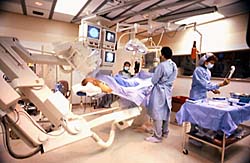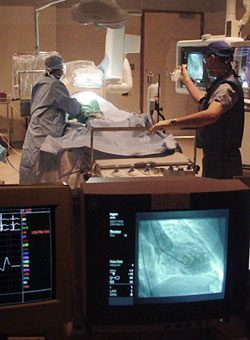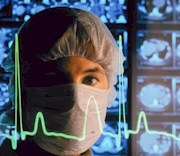Electrophysiology studies, or EPS, use cardiac catheterization techniques to study patients who have irregular heartbeats (called arrhythmias). EPS shows how the heart reacts to controlled electrical signals. These signals can help doctors find out where in the heart the arrhythmia starts and what medicines will work to stop it. EPS can also help doctors know what other catheter techniques could be used to stop the arrhythmia (see Arrhythmia).
How does it work?
Doctors will perform a cardiac catheterization procedure in which a long, thin tube (called a catheter) will be put into an artery in your leg and threaded into your heart. This catheter can be used to send the electrical signals into your heart.
|

|
|
Catheterization laboratory
|
Stimulating the heart will cause an arrhythmia, and doctors can record where in the heart it started. In some cases, you might be given a medicine to cause an arrhythmia. Certain medicines can also be given through the catheter to see which ones will stop the arrhythmia.
What should I expect?
Do not eat or drink anything after midnight the night before your test. If you have diabetes, you should talk to your doctor about your food and insulin intake, because not eating can affect your blood sugar levels.
Talk to your doctor about any medicines (prescription, over-the-counter, or supplements) that you are taking, because he or she may want you to stop taking them before the test. Also, it may be helpful to make a list of your medicines and bring it with you to the procedure, so that doctors know exactly what you are taking and how much. You will most likely have blood tests, an electrocardiogram, and a chest x-ray taken before the procedure.
|

|
|
View from the control room of a cath lab.
|
Once you are in the catheterization laboratory (also called the cath lab), you will see television monitors, heart monitors, and blood pressure machines. You will be asked to lie down on an examination table.
Electrodes will be placed on your chest. These electrodes have wires called leads, which hook up to an electrocardiogram machine. This machine will monitor your heart rhythm during the test.
To prevent infection, you will be shaved and cleansed around the area of your leg where the catheter will be inserted.
A needle with a tube connected to it will be put in your arm. This is called an intravenous line or IV. You will get a mild sedative through the IV to relax you throughout the test.
You will be given an anesthetic medicine with a needle to numb the area around where the catheter will be inserted. You may feel mild discomfort. Next, a small incision will be made in the skin. Once doctors see the artery into which the catheter will go, a special needle is used to poke into it. Doctors then put the catheter into the artery in your leg. You should not feel pain during this part of the test.
The catheter is gently threaded through the artery and into your heart. Once the catheter is in place, doctors will give your heart small electrical impulses to make it beat at different speeds. You will be able to feel your heartbeat changing speeds, and this may cause some mild discomfort. After the doctors have the information they need, the catheter and IV will be removed. Firm pressure will be applied to the site where the catheter was inserted to stop any bleeding. You will also be bandaged.
You will be moved to another room where you will need to rest for a few hours. You may feel a little sleepy until the sedative has worn off. You should try to lie still and not bend your knee too much. Nurses will watch you to see that your heart rate and blood pressure are normal. After this time of rest, you will be able to go home.
See on other sites:
MedlinePlus
https://medlineplus.gov/ency/article/003867.htm
Intracardiac electrophysiology study (EPS)
Updated August 2016



